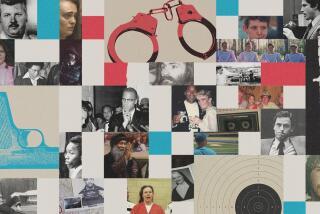Zakaria Erzinclioglu, 50; Childhood Interests Led to Forensic Entomology
“There are many paths to the truth,” Zakaria Erzinclioglu, Britain’s leading forensic entomologist, was fond of saying.
For Erzinclioglu, who helped solve more than 200 murders over the last quarter-century, the path to the truth was paved with flies and maggots.
Erzinclioglu, whose application of insect biology to the investigation of crimes earned him an international reputation, died Sept. 26 of a heart attack in England, although his death was not immediately reported in the London press. He was 50.
In simple language, the self-described “maggotologist” provided the scientific basis for his expertise in his book “Maggots, Murder and Men: Memories and Reflections of a Forensic Entomologist,” which was published in the United States in January: “When a body begins to decompose, it releases volatile compounds with particular chemical compositions. These are the odors that attract a fly to a corpse.”
Once the odors disappear, typically within a few weeks of death “whether the body is buried or not,” flies ignore the corpse, he wrote. By calculating the age of the flies and the fly larvae found on the body, a forensic entomologist can determine with a high degree of confidence when the person died.
The enormous number and variety of insects -- Britain has about 5,000 fly species -- also can help investigators trace a body’s movements.
If an insect found only indoors or in one region shows up on a body discovered in another area, for example, forensic entomologists can conclude “the body had been lying somewhere else, buried and exhumed,” he said.
Flies also will be attracted to wounds. And, according to Erzinclioglu, “even if the wound has been eaten away and there is nothing to see when the body is found, the evidence of maggots can hint at a possible cause of death.”
Erzinclioglu received his first call from the police in the early 1970s seeking somebody who was familiar with maggots. The Hungarian-born Erzinclioglu, affectionately dubbed “Dr. Zak” by police and others who had difficulty pronouncing his name, averaged a dozen calls a year from police detectives seeking his expertise.
The better-known crimes Erzinclioglu helped solve include that of Robert “Smelly Bob” Black, who was convicted in 1994 of murdering and raping three girls.
Police also consulted Erzinclioglu during the 1985 investigation of the murder of a 14-year-old boy by members of a pedophile ring. Erzinclioglu provided evidence that showed the boy had been killed indoors rather than in the woods where his body was found.
Erzinclioglu also helped convict Dr. Sampson Perera, a dental lecturer accused of murdering a 13-year-old girl whom he had illegally adopted and kept as a slave. Perera, according to news accounts, chopped the girl’s body into pieces and then hid them around his laboratory, house and garden.
After the remains were found, Perera claimed they were sterile bones he used for medical research. But Erzinclioglu identified a type of fly that was still on some of the bones, thus proving that the body had been recently dismembered.
He also helped Welsh police identify the skeletal remains of a teenage girl. By examining insect material discovered near the remains, he was able to determine that she had been dead at least five years. The police were able to narrow their search through missing-person reports and subsequently identify the remains.
By studying the developmental stage of the maggots found in the body of another young woman, Erzinclioglu was able to estimate the day she died. With that information, police investigators turned their attention to a male friend of the victim who had been seen with her that day. The friend later confessed to having stabbed the woman 57 times.
“His ability to examine a body and conclusively determine the day of death was such-and-such has saved police a tremendous amount of time,” Clive Jones, a retired Welsh detective chief superintendent, told the Associated Press last year. “How on earth can you conduct an investigation, interview suspects and eliminate people on alibi if you don’t know when the victim died?”
Born in Hungary in 1951 to parents of Turkish origin, Erzinclioglu grew up in Egypt, the Sudan and England, where he contracted polio, which left him with a limp.
After earning a degree in applied zoology from Wolverhampton Polytechnic in 1975, he worked from 1976 to 1981 for the Zoological Society of London as a compiler for the Zoological Record. He then studied for his doctorate at Durham University, writing his thesis on blowfly eggs and larvae and their development.
In 1984, he moved to Cambridge University, where he worked in the zoology department and wrote about blowflies for the Naturalists’ Handbooks series, as well as writing for other publications. He also received funding to do research in forensic entomology and later was appointed director of a new Forensic Research Center at Durham University.
Erzinclioglu said his interest in forensic entomology grew out of two childhood loves.
“I was one of those little horrors who kept bringing creepy-crawlies into the house, to the disgust of my elders,” he wrote for a London Times educational supplement in April. “I was also a great fan of Sherlock Holmes. The two passions came together in forensic entomology.”
The soft-spoken Erzinclioglu was someone who could observe that “viewed dispassionately, a dead human body is a magnificent and highly nutritious resource” and assert that there is “a great deal of beauty” in the blowflies and other insects whose maggots flourish on decaying flesh.
But he was well aware that the work of a forensic entomologist does not appeal to everyone.
He told the Associated Press last year that on a typical assignment he would “put on protective clothing ... and approach the body. It is infested with maggots, and flies are buzzing about in the room.”
But no matter how unpleasant, he said, “the last aspects of your life have to be dealt with as well.”
He is survived by his wife, Sharon; a son; and two daughters.
More to Read
Sign up for Essential California
The most important California stories and recommendations in your inbox every morning.
You may occasionally receive promotional content from the Los Angeles Times.










